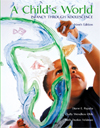Diane E. Papalia,
University of Wisconsin-Madison
Sally Wendkos Olds
Ruth Duskin Feldman
| brain growth spurts | periods of rapid growth and development
|
 |
 |
 |
| cell death | elimination of excess brain cells to achieve more efficient functioning.
|
 |
 |
 |
| central nervous system | brain and spinal cord
|
 |
 |
 |
| Denver Developmental Test | screening test given to children 1 month to 6 years old to determine whether they are developing normally.
|
 |
 |
 |
| depth perception | ability to perceive objects and surfaces three-dimensionally.
|
 |
 |
 |
| differentiation | process by which neurons acquire specialized structure and function.
|
 |
 |
 |
| fine motor skills | abilities that involve the small muscles and eye-hand coordination.
|
 |
 |
 |
| gross motor skills | physical skills that involve the large muscles.
|
 |
 |
 |
| infant mortality rate | proportion of babies born alive who die within the first year.
|
 |
 |
 |
| integration | process by which neurons coordinate the activities of muscle groups.
|
 |
 |
 |
| lateralization | tendency of each of the brain's hemispheres to have specialized functions
|
 |
 |
 |
| myelination | process of coating neurons with a fatty substance (myelin) that enables faster communication between cells.
|
 |
 |
 |
| neurons | nerve cells
|
 |
 |
 |
| plasticity | modifiability or "molding" of the brain through experience.
|
 |
 |
 |
| reflex behaviors | automatic, involuntary, innate responses to stimulation.
|
 |
 |
 |
| sudden infant death syndrome | sudden and unexplained death of an apparently healthy infant.
|
 |
 |
 |
| systems of action | increasingly complex combinations of skills, which permit a wider or more precise range of movement and more control of the environment.
|
 |
 |
 |
| visual cliff | apparatus designed to give an illusion of depth and used to assess depth perception in infants.
|



 2002 McGraw-Hill Higher Education
2002 McGraw-Hill Higher Education